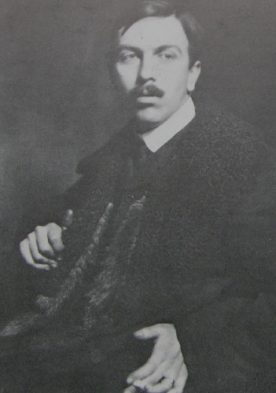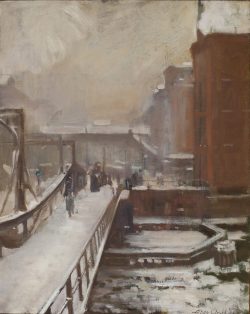Alson Skinner Clark, from an early photograph reproduced in Jean Stern, Alson S. Clark (Los Angeles: Petersen Publishing Co., 1983).

Alson Skinner Clark 1876–1949
A native of Chicago, Alson Skinner Clark as a youth attended classes at the Art Institute of Chicago and spent two years in Europe with his family. The son of a Chicago commodities trader, Clark also spent idyllic periods at his family’s island home on Alexandria Bay, on New York’s St. Lawrence River. After completing high school in Chicago, Clark enrolled as a fulltime student at the Art Institute but soon left for New York to study at the Art Students League and with William Merritt Chase. In 1898 he returned to Europe for two years, studying under James McNeill Whistler in Paris; he also worked in the Breton village of Le Pouldu, site of an international artists’ colony. Returning to the U.S. in 1900, Clark lived in Watertown, New York, and in Chicago, where he began exhibiting in the Art Institute’s annual shows and created a commissioned mural in an elementary school.
Newly married to Atta Medora McMullin, who sometimes served as his model, Clark was back in Europe in 1902. Based in Paris, he also worked in Brittany and Italy, painting both figural works and landscapes that around 1907 began to manifest the broken brushwork and strong outdoor color and light of impressionism. In addition to seeing his work juried into the prestigious Paris Salon exhibitions, Clark found exposure and sales in American venues ranging from the 1904 Louisiana Purchase Exposition (where he won a bronze medal) to the Society of American Artists’ 1905 show, as well as the Art Institute’s American art annuals; the museum gave him solo shows in 1906 and 1916. In the Art Institute’s catalogues, beginning in 1907, Clark alternately listed Watertown, Chicago, and Alexandria Bay as his address. In 1913 he traveled to Panama to paint a series of works depicting the construction of the new canal and around that time he revisited Paris and traveled to Charleston, South Carolina.
Clark served as an aerial photographer in the U.S. Army during World War I. Partly for his health, in 1920 he relocated to Southern California, immersing himself in the region’s burgeoning art scene. In 1921, he joined the faculty of the Stickney School of Fine Arts in Pasadena and soon thereafter he became its director. From his California studio, Clark traveled and exhibited widely. He also took on several significant mural commissions. Although his work was distinctly behind the times by the 1930s, the artist was honored with several solo shows, notably at the San Diego Museum of Art in 1938 and at the Los Angeles Museum of History, Science and Art (now the Los Angeles County Museum of Art) in 1940. Clark was still painting the day before his death, at age seventy-three.
Wendy Greenhouse, PhD
